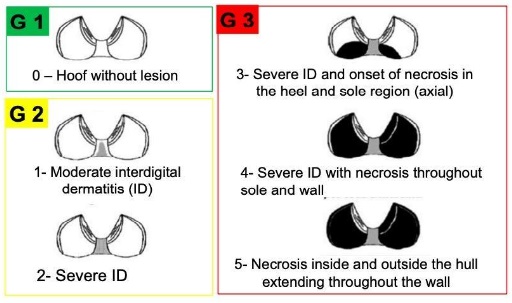Characterization of hoof injuries in sheep (Ovis aries) in the State of Tocantins, Brazil
DOI:
https://doi.org/10.21708/avb.2023.17.3.11864Resumo
The aim of this study was to characterize and establish the prevalence of foot lesions and stages of footrot in sheep flocks in the State of Tocantins, Brazil, during dry and moist seasons. A total of 339 sheep (Ovis aries) were examined during the period of September 2014 to May of 2015. Procedures for animal examination and age estimation were performed. All animals were divided in three groups: G1, G2 and G3 using the Egerton's modified score system for footrot. Foot lesions were classified as: double sole (DS), overgrowth (OG), white line disease (WLD), moderate interdigital dermatitis (MID), severe interdigital dermatitis (SID), horizontal crack (HC) and other injuries (OI). No significant difference was observed when comparing the same group in different periods, however there was difference between groups in the same period. In dry and moist season, G1 was greater than G2 and G3. The most prevalent lesion per limb observed in dry and moist season was OG. This difference was also observed for DS, OG+WLD, OG+MID, OG+SID, OG+HC and OI. The only lesion that was more prevalent in dry season when compared to moist season was OG+DS. This exploratory study provides key insight into the prevalence of foot lesions of sheep in two distinct seasons, and the occurrence of concomitant lesions. Animals of all ages were classified as moderate to severe footrot according to the modified Egerton scoring system, during moist season.
Downloads

Downloads
Publicado
Edição
Seção
Licença
Copyright (c) 2023 Acta Veterinaria Brasilica

Este trabalho está licenciado sob uma licença Creative Commons Attribution 4.0 International License.
Autores que publicam na Acta Veterinaria Brasilica concordam com os seguintes termos: a) Autores mantém os direitos autorais e concedem à revista o direito de primeira publicação, com o trabalho simultaneamente licenciado sob a Licença Creative Commons Attribution que permite o compartilhamento do trabalho com reconhecimento da autoria e publicação inicial nesta revista. b) Autores têm autorização para assumir contratos adicionais separadamente, para distribuição não-exclusiva da versão do trabalho publicada nesta revista (ex.: publicar em repositório institucional ou como capítulo de livro), com reconhecimento de autoria e publicação inicial nesta revista. c) Autores têm permissão e são estimulados a publicar e distribuir seu trabalho online (ex.: em repositórios institucionais ou na sua página pessoal) a qualquer ponto antes ou durante o processo editorial, já que isso pode gerar alterações produtivas, bem como aumentar o impacto e a citação do trabalho publicado (Veja O Efeito do Acesso Livre).


 Esta obra está licenciada com uma Licença
Esta obra está licenciada com uma Licença 